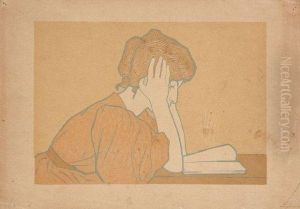Alexandre Louis M. Charpentier Paintings
Alexandre Louis Marie Charpentier, born in 1856 in Paris, France, was a multifaceted artist known for his work as a sculptor, medallist, cabinet maker, and decorative artist. His contributions to the art world crossed several mediums, showcasing his versatility and creativity. Charpentier's work is often associated with the Art Nouveau movement, a style that emphasized organic shapes, flowing lines, and often incorporated elements from nature. This movement sought to erase the boundaries between the major and minor arts, aiming to elevate the decorative arts to the status of fine arts.
Charpentier's early life and education played a significant role in shaping his artistic direction. Though details of his early education are not extensively documented, it is known that he immersed himself in the vibrant artistic culture of Paris, which was at the heart of the Art Nouveau movement. His work stood out for its innovative approach and his ability to infuse traditional techniques with new, imaginative ideas. Charpentier was not just a practitioner but also an advocate for the integration of art into daily life, believing that beauty should not be confined to galleries and museums but should be accessible in everyday objects and living spaces.
Throughout his career, Alexandre Charpentier collaborated with other artists and engaged in various artistic communities, contributing to the dynamism of the Art Nouveau movement. His works were exhibited in numerous exhibitions, gaining recognition and accolades. Notably, his medallions and plaques were celebrated for their exquisite craftsmanship and unique aesthetic that combined elegance with a sense of realism. Beyond his sculptural work, Charpentier's contributions to decorative arts included furniture design and interior decorations, embodying the principles of Art Nouveau and influencing the direction of modern design.
Charpentier's legacy extends beyond his contributions to the Art Nouveau movement. He is remembered for his dedication to artisanship and his vision of a world where art is woven into the fabric of society. His works continue to be studied and admired for their artistic innovation and their role in the transition towards modern art and design. Alexandre Louis Marie Charpentier passed away in 1909, leaving behind a body of work that continues to inspire artists and designers to this day.

